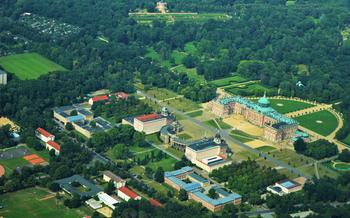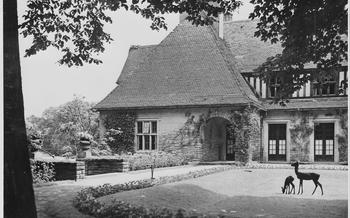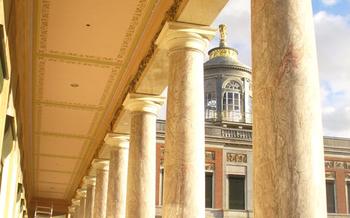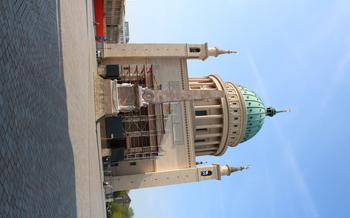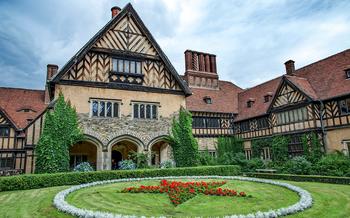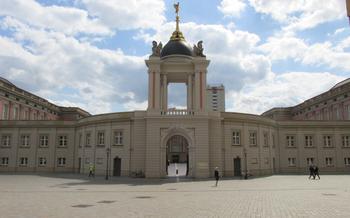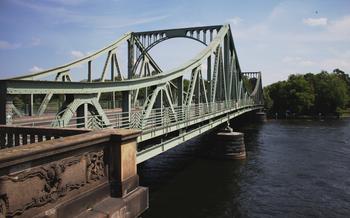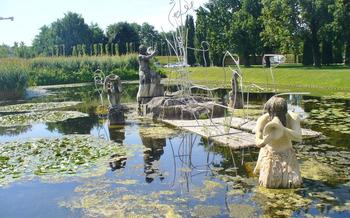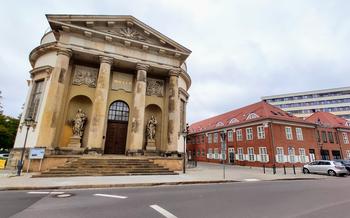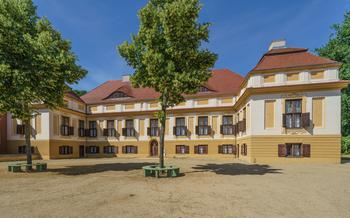
The Nauen Gate (Nauener Tor)
- The Nauen Gate (Nauener Tor): A Historical Overview
- Location and Accessibility
- Exploring the Gate
- Historical Context
- Architectural Features
- Fortifications and City Walls
- Prussian Kings and Potsdam
- World War II and Reconstruction
- Cultural Events and Festivals
- Nearby Attractions:
- Practical Information:
- Photography and Social Media : Sharing the Beauty of the Nauen Gate
- Local Cuisine and Restaurants:
- Souvenirs and Shopping:
- Insider Tip: Uncovering Potsdam's Hidden Gems
The Nauen Gate (Nauener Tor): A Historical Overview
Standing proudly as a testament to Potsdam's rich past, the Nauen Gate (Nauener Tor) has witnessed centuries of history unfold. Erected in 1755 under the reign of Frederick the Great, this imposing structure served as a vital entrance to the city, welcoming travelers and safeguarding its inhabitants. As one of the few remaining city gates in Potsdam, the Nauen Gate stands as a symbol of the city's resilience and its enduring legacy as a Prussian stronghold.
Distinguished by its striking architectural style, the Nauen Gate is a masterpiece of Baroque architecture. Its grand facade, adorned with intricate carvings and sculptures, reflects the artistic sensibilities of the era. The gate's imposing size and symmetrical design create a sense of grandeur, emphasizing its significance as an entry point to the city.
Throughout its existence, the Nauen Gate has played a pivotal role in Potsdam's history. It served as a defensive fortification during times of war, protecting the city from invading forces. The gate also witnessed the triumphant processions of Prussian armies returning from victorious battles, their banners waving proudly as they marched through its archway.
Location and Accessibility
The Nauen Gate stands proudly at the western edge of Potsdam's Old Town, marking the entrance to the city's historic center. Its exact address is Nauener Tor 1, 14467 Potsdam, Germany. To reach the gate, visitors can take advantage of the city's well-developed public transportation system. The nearest tram stop is "Nauener Tor," served by tram lines 92 and 9Alternatively, visitors can hop on bus lines 605 or 695, which also stop close to the gate. For those arriving by car, limited parking spaces are available in the vicinity of the Nauen Gate, but it's advisable to use public transportation or explore the city on foot to fully immerse in its charm.
Situated in the heart of Potsdam, the Nauen Gate is surrounded by a myriad of attractions. Just a stone's throw away lies the Brandenburg Gate, another iconic landmark of the city. History buffs can delve deeper into Potsdam's past at the nearby Potsdam Museum, while art enthusiasts will find solace in the Museum Barberini, showcasing a remarkable collection of Impressionist and Modern art. The Sanssouci Palace, a UNESCO World Heritage Site, is also within easy reach, inviting visitors to explore its opulent gardens and architectural wonders.
Exploring the Gate
The Nauen Gate stands as a testament to the architectural prowess of its time, showcasing intricate details that captivate the eye. Admire the meticulously crafted sandstone reliefs adorning the gate's exterior, depicting scenes from Greek mythology and Prussian history. Look out for the crowned eagle, a symbol of Prussian royalty, perched majestically atop the gate.
Delve into the gate's interior spaces, which offer a glimpse into its historical significance. Explore the guardroom, where soldiers once stood watch, and imagine the bustling atmosphere of centuries past. Discover informative exhibits that shed light on the gate's construction, its role in Potsdam's defense, and the events that have unfolded within its walls.
For a deeper understanding of the gate's history and architecture, consider joining a guided tour. Knowledgeable guides will provide fascinating insights into the gate's construction, its significance in Potsdam's history, and the stories of those who passed through its archway. Audio guides are also available, offering a self-paced exploration at your own convenience.
Historical Context
Potsdam's strategic location on the banks of the Havel River and its proximity to Berlin made it a significant city in Prussian and German history. The Nauen Gate played a crucial role in shaping the city's development and witnessed numerous historical events.
During the reign of Frederick the Great, Potsdam flourished as a center of arts and culture. The gate served as a grand entrance to the city, welcoming dignitaries and visitors from across Europe. It also played a pivotal role in the defense of the city during the Seven Years' War (1756-1763), withstanding attacks from Austrian and Russian forces.
In the 19th century, Potsdam became a popular destination for tourism and recreation. The Nauen Gate, with its picturesque setting and historical significance, attracted numerous visitors who marveled at its architectural beauty and explored the city's rich history.
During the tumultuous period of the World Wars, Potsdam and the Nauen Gate endured significant challenges. The city was heavily damaged during World War II, and the gate suffered severe damage. However, after the war, the gate was meticulously restored to its former glory, symbolizing the resilience and determination of the people of Potsdam.
Architectural Features
The Nauen Gate is an impressive example of Baroque architecture, characterized by its ornate and exuberant style. The gate's façade features intricate carvings and sculptures, including cherubs, garlands, and military trophies. The central archway is flanked by two smaller arches, each topped with an elaborate pediment. The gate's overall design is symmetrical and harmonious, creating a sense of grandeur and monumentality.
The Nauen Gate is constructed from red brick and sandstone, materials commonly used in the construction of fortifications during the 18th century. The gate's exterior is adorned with various decorative elements, including quoins, pilasters, and cornices. The gateway is surmounted by a triangular pediment, which features a relief depicting the Prussian eagle with the motto "Suum Cuique" (To each his own).
The gate shares some similarities with other notable gates in Germany, particularly the Brandenburg Gate in Berlin. Both gates feature a central archway flanked by smaller arches, as well as elaborate sculptural decorations. However, the Nauen Gate is unique in its overall design and the use of red brick as the primary building material.
Fortifications and City Walls
The Nauen Gate is an integral part of Potsdam's impressive fortifications, which played a crucial role in the city's defense and security throughout history. The gate was one of several that guarded the entrances to the city, along with the Brandenburg Gate, the Jägertor, and the Berliner Tor. These gates were strategically positioned along the city walls, forming a formidable barrier against potential invaders.
The city walls of Potsdam were constructed in the 17th century under the reign of Frederick William I, the "Soldier King." The walls were made of brick and reinforced with earthworks, creating a sturdy defense system. The walls stretched for approximately 6 kilometers, encircling the city and protecting it from attacks.
Today, only remnants of the city walls remain, including the Nauen Gate. These remnants serve as a reminder of Potsdam's rich history and the importance of fortifications in protecting cities during times of conflict. Visitors can explore these remnants and gain insights into the city's past, imagining the bustling streets and defensive measures of centuries gone by.
Prussian Kings and Potsdam
The Hohenzollern dynasty, which ruled Prussia for over 500 years, played a pivotal role in the development of Potsdam. The city served as a residence and a military stronghold for the Prussian kings, who left a lasting impact on its architecture and urban landscape.
Frederick William I, known as the "Soldier King," transformed Potsdam into a garrison town and established the Potsdam Giant Grenadiers, a regiment of exceptionally tall soldiers. He also initiated the construction of the Nauen Gate and other fortifications to strengthen the city's defenses.
His son, Frederick the Great, continued the Hohenzollern legacy by expanding Potsdam's military prowess and cultural significance. He commissioned the construction of numerous palaces and gardens, including the world-renowned Sanssouci Palace, which became a symbol of Prussian grandeur.
The Hohenzollern kings not only shaped the physical appearance of Potsdam but also contributed to its intellectual and artistic flourishing. They attracted renowned artists, scientists, and philosophers to their court, creating a vibrant cultural scene that rivaled that of other European capitals.
The architectural legacy of the Prussian era can still be seen throughout Potsdam, with many buildings showcasing a mix of Baroque, Rococo, and Neoclassical styles. The Nauen Gate, with its imposing presence and intricate details, stands as a testament to the Hohenzollern dynasty's enduring influence on the city.
World War II and Reconstruction
The Nauen Gate, like many other structures in Potsdam, did not escape the devastation of World War II. During the intense Allied air raids that targeted the city in 1945, the gate sustained significant damage. The once-proud structure was reduced to a mere shell, its grand facade scarred by gaping holes and its interior gutted by the relentless flames.
The aftermath of the war presented a daunting challenge for the people of Potsdam. The city lay in ruins, and the Nauen Gate stood as a poignant reminder of the destruction that had been wrought upon their beloved city. However, the indomitable spirit of the Potsdammers shone through as they embarked on the arduous task of rebuilding their city and restoring its landmarks to their former glory.
The reconstruction of the Nauen Gate began in the 1950s, a painstaking process that required meticulous attention to detail and a deep understanding of the original architectural design. Craftsmen and artisans worked tirelessly to recreate the intricate carvings, moldings, and ornaments that had once adorned the gate. Using a combination of traditional techniques and modern materials, they breathed new life into the historic structure.
Today, the Nauen Gate stands as a testament to the resilience and determination of the Potsdammers. It has been carefully restored to its pre-war splendor, once again serving as a symbol of the city's rich history and cultural heritage. Visitors can marvel at its restored beauty and appreciate the painstaking efforts that went into its reconstruction, a testament to the enduring spirit of Potsdam.
Cultural Events and Festivals
The Nauen Gate and its surroundings come alive during various cultural events and festivals throughout the year. These events offer visitors a chance to delve deeper into Potsdam's history and traditions. One of the highlights is the Nauener Torfest, an annual festival held in August. The festival features historical reenactments, live music, traditional crafts demonstrations, and food stalls serving local delicacies. Visitors can witness the gate's transformation into a vibrant marketplace, bustling with activities reminiscent of its past.
The Potsdamer Schlössernacht (Potsdam Palace Night) is another popular event that takes place in the summer. During this night of enchantment, the parks and palaces of Potsdam, including the Nauen Gate, are illuminated with thousands of lights, creating a magical atmosphere. Visitors can enjoy live music concerts, art exhibitions, guided tours, and theatrical performances.
Cultural events are not limited to the summer months. During the Potsdamer Winterzauber (Potsdam Winter Magic) in December, the Nauen Gate area transforms into a winter wonderland. Christmas markets, ice skating rinks, and festive decorations create a cozy and charming ambiance. Visitors can indulge in mulled wine, roasted chestnuts, and traditional German Christmas treats while browsing for unique gifts and souvenirs.
Nearby Attractions:
The Nauen Gate stands as a proud sentinel amidst an array of historical treasures in Potsdam. Just a short stroll away, visitors can delve into the rich tapestry of the past at the Potsdam City Museum. Housed in the Old Town Hall, this museum showcases the city's fascinating history through engaging exhibits and artifacts.
For those seeking artistic inspiration, the surrounding streets are adorned with galleries showcasing contemporary and classical works. Art enthusiasts can wander through these galleries, admiring the diverse talents of local and international artists.
Nature lovers will find solace in the nearby Sanssouci Park, a sprawling green oasis that was once the playground of Prussian kings. With its elegant gardens, tranquil ponds, and majestic palaces, Sanssouci Park offers a serene escape from the urban hustle and bustle.
To complete your historical immersion, visit the Cecilienhof Palace, located within walking distance of the Nauen Gate. This striking palace served as the backdrop for the Potsdam Conference in 1945, where the fate of post-war Europe was decided.
With its wealth of attractions, Potsdam offers a fulfilling day trip or an extended stay for those seeking a deeper exploration of German history and culture.
Practical Information:
Admission to the Nauen Gate is free of charge, allowing visitors to explore its grandeur without any financial barriers. It is open to the public during daylight hours, providing ample opportunities for exploration and photography. The gate's accessible design ensures that visitors with disabilities can comfortably navigate its spaces. Restrooms and basic amenities are available nearby, catering to the convenience of all visitors. Whether you're a history buff, an architecture enthusiast, or simply seeking a unique cultural experience, the Nauen Gate welcomes you to immerse yourself in its rich tapestry of stories and architectural beauty.
Photography and Social Media : Sharing the Beauty of the Nauen Gate
With its striking architecture and historical significance, the Nauen Gate is a popular subject for photography enthusiasts and social media influencers. To capture stunning photos that showcase the gate's grandeur, consider using a wide-angle lens to emphasize its size and majesty. Experiment with different angles to find unique perspectives, such as shooting from a low angle to create a dramatic effect or from above to capture the gate's intricate details.
For the best lighting conditions, visit the gate during the golden hours of sunrise or sunset, when the warm hues of the sky will enhance the gate's appearance. Take advantage of the surrounding greenery to add a touch of natural beauty to your shots. Incorporate elements like trees, flowers, or the cobblestone streets to create a sense of depth and context.
Don't forget to share your experiences with the world on social media! Use relevant hashtags like #NauenerTor, #Potsdam, and #Brandenburg to reach a wider audience. Share your photos, videos, and stories to inspire others to explore this historical gem. Tag @VisitPotsdam or @BrandenburgTourism to connect with the local tourism community and be featured on their pages.
Remember to be respectful of the gate and its surroundings while taking photos. Avoid using flash photography, as it can be disruptive to visitors and damage the gate's delicate surfaces. Ask permission before photographing people, and be mindful of their privacy.
Finally, remember to savor the moment as you capture the essence of the Nauen Gate through your lens. Let the gate's history and beauty inspire your creativity, and share your unique perspective with the world.
Local Cuisine and Restaurants:
Potsdam offers a culinary journey that blends traditional German flavors with modern culinary influences. To fully immerse yourself in the city's culinary scene, try local specialties such as "Potsdamer Kartoffelsuppe" (potato soup) or "Berliner Currywurst" (fried sausage with curry ketchup). For a taste of traditional German cuisine, head to Zur letzten Instanz, a historic restaurant housed in a former Prussian court building. Alternatively, visit Zur Haxe, renowned for its crispy pork knuckle served with sauerkraut and mashed potatoes. If you prefer a lighter meal, try the "Flammkuchen" (Alsatian flatbread with various toppings) at Zur Alten Wache, located in the heart of Potsdam's Old Town. For a unique dining experience, take a boat trip on the Havel River and enjoy a meal at one of the many restaurants lining the waterfront.
Souvenirs and Shopping:
As you explore the area around the Nauen Gate, take the opportunity to delve into Potsdam's vibrant shopping scene. Discover charming local shops and boutiques showcasing a range of unique souvenirs and handcrafted items. Support local artisans by purchasing one-of-a-kind pieces that reflect the city's rich history and culture. Browse traditional German souvenirs such as cuckoo clocks, beer steins, and miniature figurines. Indulge in local delicacies like freshly baked pastries, artisanal chocolates, and specialty jams. Visit the nearby markets to find fresh produce, local cheeses, and handmade crafts. By shopping locally, you not only take home cherished mementos but also contribute to the preservation of traditional skills and the local economy.
Insider Tip: Uncovering Potsdam's Hidden Gems
Beyond the Nauen Gate, Potsdam holds a treasure trove of hidden gems waiting to be discovered. For a unique experience, venture off the beaten path and explore the enchanting Dutch Quarter. This charming neighborhood, just a short walk from the gate, features picturesque canals, colorful houses, and cozy cafes. Stroll along the cobblestone streets, admire the unique architecture, and soak in the tranquil atmosphere.
If you're a history buff, delve into the intriguing stories of Potsdam's past at the Brandenburg State Museum. This hidden gem, housed in a former palace, showcases fascinating exhibits on the city's rich history, from its royal roots to its modern-day transformation. Discover forgotten tales and uncover the hidden layers of Potsdam's past within these museum walls.
To escape the hustle and bustle, seek refuge in the tranquil confines of the Sanssouci Park. This sprawling park, a UNESCO World Heritage Site, offers a serene haven amidst the city's vibrant energy. Stroll through its manicured gardens, admire the elegant palaces, and soak in the tranquility of nature. Whether you're seeking a peaceful retreat or a picturesque backdrop for a picnic, Sanssouci Park promises an unforgettable experience.
